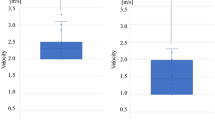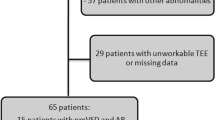Abstract
This study aimed to examine the definition and indications for surgery, to elucidate the morphologic substrate of aortic regurgitation, and to extrapolate the pathologic mechanisms of subpulmonary stenosis in Eisenmenger ventricular septal defect (EVSD). The study enrolled 160 patients. Preoperative respiratory symptoms and poor growth were present in 41 patients (26%), and 21 patients (13%) required mechanical ventilation. Perimembranous ventricular septal defect (pVSD) had been diagnosed previously for 136 of the patients (85%) at other institutions. Of the 160 patients, 51 (32%) had muscular posteroinferior rims. Aortic regurgitation was experienced by 36 patients (23%), found to be mild in 31 cases (19%) and moderate in 5 cases (3%). None of the patients had severe regurgitation. No aortic valvuloplasty was performed. The significant risk factors for aortic regurgitation were subpulmonary stenosis (p = 0.001) and a muscular posteroinferior rim (p = 0.000). Subpulmonary stenosis was seen in 57 patients (35%), found to be mild to moderate in 42 cases (26%) and severe in 15 cases (9%). Adequacy of the stenosis band was repaired through the tricuspid valve for 57 of these patients. The definition of EVSD should identify it as a subgroup different from pVSD, and it should be closed as soon as it is identified in developing countries. Aortic regurgitation occurs rarely, and aortic valvoplasty should be performed if it exceeds a moderate level. The subpulmonary stenosis can be repaired through the tricuspid valve.
Similar content being viewed by others

References
Anderson RH, Wilcox BR (1993) The surgical anatomy of ventricular septal defects associated with overriding valvar orifices. J Card Surg 8:130–142
Oppenheimer-Dekker A, Gittenberger-de Groot AC, Bartelings MM et al (1985) Abnormal architecture of the ventricles in hearts with an overriding aortic valve and a perimembranous ventricular septal defect (“Eisenmenger VSD”). Int J Cardiol 9:341–355
Soto B, Becker AE, Moulaert AJ et al (1980) Classification of ventricular septal defects. Br Heart J 43:332–343
Fukuda T, Suzuki T, Ito T (2000) Clinical and morphologic features of perimembranous ventricular septal defect with overriding of the aorta—the socalled Eisenmenger ventricular septal defect: a study making comparisons with tetralogy of Fallot and perimembranous ventricular defect without aortic overriding. Cardiol Young 10:343–352
Bhatt M, Roth SJ, Kumar RK et al (2004) Management of infants with large, unrepaired ventricular septal defects and respiratory infection requiring mechanical ventilation. J Thorac Cardiovasc Surg 127:1466–1473
Vaidyanathan B, Roth SJ, Rao SG et al (2002) Outcome of ventricular septal defect repair in a developing country. J Pediatr 140:736–741
Cheung YF, Chiu CS, Yung TC, Chau AK (2002) Impact of preoperative aortic cusp prolapse on long-term outcome after surgical closure of juxta-arterial ventricular septal defect. Ann Thorac Surg 73:622–627
Elgamal MA, Hakimi M, Lyons JM, Walters HL III (1999) Risk factors for failure of aortic valvuloplasty in aortic insufficiency with ventricular septal defect. Ann Thorac Surg 68:1350–1355
Lue HC, Sung TC, Hou SH et al (1986) Ventricular septal defect in Chinese with aortic valve prolapse and aortic regurgitation. Heart Vessels 2:111–116
Lun K, Li H, Leung MP et al (2001) Analysis of indications for surgical closure of juxta-arterial ventricular septal defect without associated aortic cusp prolapse and aortic regurgitation. Am J Cardiol 87:1266–1270
Gatzoulis MA, Soukias N, Ho SY et al (1999) Echocardiographic and morphological correlations in tetralogy of Fallot. Eur Heart J 20:221–231
McCarthy KP, Ho SY, Anderson RH (2000) Categorisation of ventricular septal defects: review of the perimembranous morphology. Images Paediatr Cardiol 3:24–40
Jacobs JP, Burke RP, Quintessenza JA, Mavroudis C (2000) Congenital Heart Surgery Nomenclature and Database Project: ventricular septal defect. Ann Thorac Surg 69(4 Suppl):S25–S35
Takenaka K, Dabestani A, Gardin JM et al (1986) A simple Doppler echocardiographic method for estimating severity of aortic regurgitation. Am J Cardiol 57:1340–1343
Rowlatt JF, Rimoldi HJA, Lev M (1963) The quantitative anatomy of the normal child’s heart. Pediatr Clin North Am 10:499–507
Wells WJ, Lindesmith GG (1985) Ventricular septal defect. In: Arciniegas E (ed) Pediatric cardiac surgery 1985. Year Book Medical, Chicago, pp 141–153
Mitchell SC, Korones SB, Berendes HW (1971) Congenital heart disease in 56,109 births: incidence and natural history. Circulation 43:323–332
Van Praagh R, Geva AT, Kreutzer J (1989) Ventricular septal defects: how shall we describe, name, and classify them? J Am Coll Cardiol 14:1298–1299
Chiu SN, Wang JK, Lin MT et al (2005) Aortic valve prolapse associated with outlet-type ventricular septal defect. Ann Thorac Surg 79:1366–1371
Ueda M, Fujimoto T, Becker AE (1986) The infundibular septum in normal hearts and in hearts with isolated ventricular septal defect: a comparison between Japanese and Dutch hearts. Jpn Heart J 27:635–643
Momma K, Toyama K, Takao A et al (1984) Natural history of juxta-arterial infundibular ventricular septal defect. Am Heart J 108:1312–1317
Anderson RH, Jacobs ML (2008) The anatomy of tetralogy of Fallot with pulmonary stenosis. Cardiol Young 18(Suppl 3):12–21
Van Praagh R (2009) The First Stella Van Praagh Memorial Lecture: the history and anatomy of tetralogy of Fallot. Semin Thorac Cardiovasc Surg Pediatr Card Surg Ann 12:19–38
Jonas RA (2004) Tetralogy of Fallot with pulmonary stenosis. In: Jonas RA (ed) Comprehensive surgical management of congenital hear disease 2004. Arnold, London, pp 279–300
Acknowledgments
We thank our colleagues at Shanghai Children Medical Center for allowing us to study their patients. This work was supported by Shanghai Natural Science Foundation 09ZR1419500.
Author information
Authors and Affiliations
Corresponding author
Rights and permissions
About this article
Cite this article
Chen, H., Xu, Z., Wang, S. et al. Eisenmenger Ventricular Septal Defect: Classification, Morphology, and Indications for Surgery. Pediatr Cardiol 32, 17–23 (2011). https://doi.org/10.1007/s00246-010-9797-3
Received:
Accepted:
Published:
Issue Date:
DOI: https://doi.org/10.1007/s00246-010-9797-3



